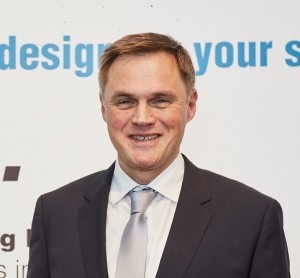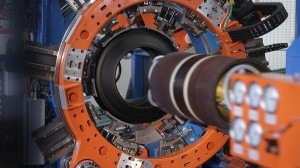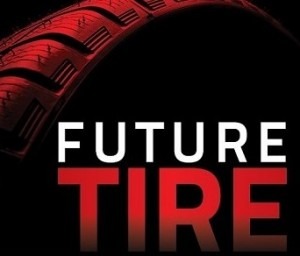After two decades of working in the tire-manufacturing sector, Markus Wachter is now guiding HF’s introduction of a new TBM technology into the market. Article originally appeared in March/April 2018 edition of European Rubber Journal magazine:
The appointment meant a move from tire-making to making machinery for Wachter, who had spent more than 20 years at Dunlop and Goodyear, including in senior engineering and manufacturing roles up to plant manager over 10 years at its plants in Germany and France.
Over the last two years, he has been steadily applying his experience in areas such as engineering, factory-planning and in the production of UHP tires at his new employer.
“What I am bringing to HF, is the knowhow of the whole tire-manufacturing process and the challenges of operation,” Wachter said in an interview with ERJ during the recent Tire Technology Expo in Hanover, Germany.
Market demands
“At the end of the day, the machine has to produce the tires on market demands with highest quality, and it has to be very ‘friendly’ for operation and maintenance, as well as cost efficient” he explained. “So, it is important to know the challenges: from the milling room to the final finishing.”
According to the VP, joining HF has provided him with new insights into how tire companies around the world are adapting to market needs. This includes seeing the tire market “not just from one customer or market perspective,” particularly as newer players have been taking market-share from the top-five tire makers over recent years.
“Today, it is about taking a truly global approach,” he said. “You can see this, for example, with all the investments the Asian players for example in China and India, are putting into the global market.”
To meet such requirements, Wachter was quick to point to HF’s current introduction of a new tire building machine (TBM) – the product of a development project, which had started around the time of his arrival from Goodyear.
According to the HF executive, the new machine, labelled One, represents an “evolutionary step” in terms of advancing the production-run capabilities of tire manufacturing plants.
Drivers
“It was a shock for many in the industry to learn that their tires had to have a quality that is really repeatable,” he said. “The quality bar has been raised, as with harmonised testing. You cannot change, as you might want to, the parameters every day. You need highly stabilised processes with less variation.”
Another factor, he said, was increasing diversification, with standard tires, SUV tires as well as low-aspect- and high-aspect-ratio tires all part of a growing product mix. This will be further expanded by electric vehicles that require tires with smaller patterns and higher diameters.
Moreover, there 1s the increasing need for production flexibility, Wachter noting that he has previously worked at tire plants with lot-sizes of less than 300 units with the SKUs running just once or twice a year.
“Manufacture is getting more and more complex,” he commented. ““The tire world is faced by different tire constructions, including those that need specific tire-building processes for high crown and flat carcass designs, TOS or SOT, as well as quick changeovers with a perfect quality output.”
Materials costs and scrap reduction are further issues seemingly addressed by the TBM, which allows the production of tires with innovative carcass designs – in part through a more effective application of ply layers and sidewall application during tire construction.
For instance, said Wachter, in producing ply-C-turn-ups in combination with wide-sidewall tires, conventional machines are limited to 180-200mm sidewall width and are limited in delivering sufficient force at the end of the ply-delivery operation.
“And, if you are faced with losing force of your turn-up fingers on the top, you have to inflate the carcass much more, putting the bead-to-bead distance closer than the final bead-to-bead distance of the green tire,” he said. “So, you are likely overstretching your ply.
“But [with the One machine] we can do up to 230mm sidewall plus, with a ply-C-turn-up and still have force on the top. We can apply the ply and make the turn-up with always putting the bead-to-bead distance during turn-up wider than the final shaping bead-to bead distance,” claimed Wachter.
Force limited
Conventional machines, he added, are limited by shaft-size, typically 140-150mm, and so can only hold small spindles inside. This, in turn, limits the force that can be applied through the spindle during tire construction.
“With our patented technology, we have moved that operation out of the shaft itself,” he said. “We are using three spindles, installed at the transfer ring, and are activating the drum from outside.
“That gives much more power: we have three strong spindles, servo-controlled and also a much longer hub, giving much more flexibility.”
The drum is also designed to run to shaping bead-to-bead distances below 200mm, compared to conventional machines, which said Wachter, can mostly only work down to 220mm.
“Our new drum can go down to 180mm,” he stated. “So, if you have a very small tire, for example for e-mobility, requiring reduced rolling resistance, you can build this with our One. We have broken down this limit dramatically.”
Wachter forecast that offering tire makers a single machine like the One machine would allow tire designers more freedom to deliver all “new evolutions” of tires.
And, predicting that, the One concept would help HF increase its current 15-20% share of the global TBM market, the former tire-maker concluded: “Today, tire companies have to show innovation and stabilise their processes.
“We want to grow with this new technology, which will help solve the operational challenges involved in manufacturing tires.”








